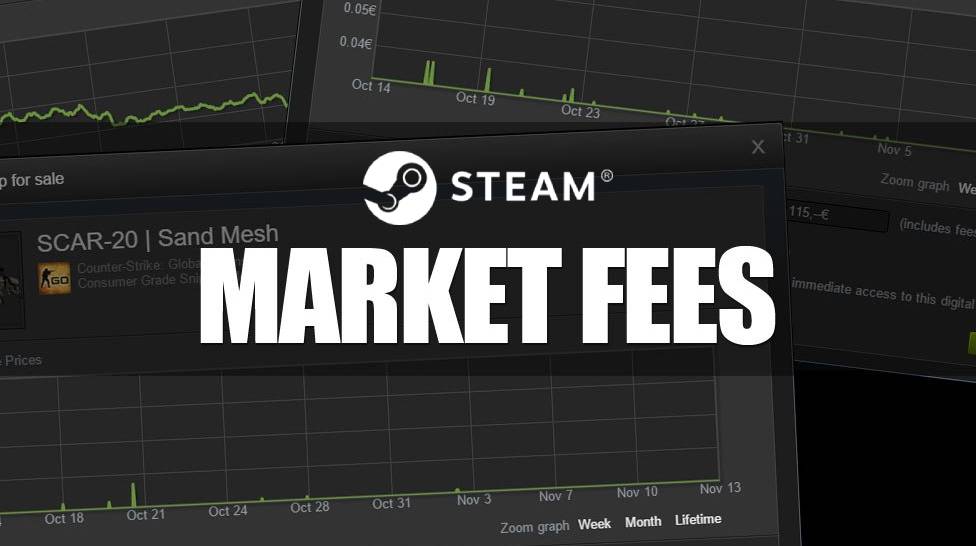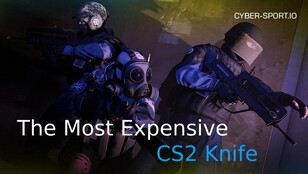This guide breaks down exactly how that Steam Market fee works, especially for CS2 skins, and what that 15% really means in practice. You’ll see a simple formula, worked examples across different price ranges, and a few subtle quirks like rounding errors or how VAT changes things depending on your region.
By the end, you’ll know exactly how much Steam takes, what ends up in your wallet, and how to check those numbers before you list your next skin.
Key Takeaways
- Standard fee: 15% total; 10% goes to the game (CS2), 5% to Steam.
- Minimums apply: The fee is rounded to the nearest cent; very cheap items can show slightly odd totals.
- Regional taxes: Some regions add VAT or GST on top of buyer prices, not your payout.
- No withdrawals: You earn Steam Wallet funds only; you can’t cash out.
- No hidden extras: Steam shows the full cut before confirming a listing.
- Reference: Steam Community Market Fees Policy.
The 15% Breakdown (10% Game Fee, 5% Steam Fee)
At the simplest level, the Steam Community Market fee is split into two parts:
- 5% platform fee for Steam itself.
- 10% game fee for the developer or publisher.
For CS2, both portions go to Valve, since it’s the publisher and the platform owner. But for other games like Rust or Dota 2, that 10% goes back to the respective studio.
When you create a listing, Steam automatically adds those fees to your asking price. The buyer sees a slightly higher total than what you’ll receive. That’s why it can feel like your sale value shrinks when it clears.
Here’s the core formula used internally by Steam:
- Net to Seller = List Price × (1 – Total Fee %)
- Where Total Fee % = 0.15 (or 15%)
And reversed:
- Buyer Price = Seller Price ÷ (1 – 0.15)
- Buyer Price = Seller Price ÷ 0.85
That second version explains why a $1.00 “seller price” looks like $1.18 to the buyer. Steam’s listing interface automates this, but if you ever wonder why the totals don’t match exactly, that’s the math behind it.
A Quick Example
Say you list your AK-47 | Redline (Field-Tested) for $10.00.
- Steam’s 5% = $0.50.
- CS2’s 10% = $1.00.
- You receive $8.50 in your wallet.
That’s the base rule. It doesn’t change with volume, time, or rarity, only with the item’s price.
Worked Examples (Across Common Price Points)
To make things easier, here’s a set of quick reference points. These reflect CS2’s fixed 15% total fee.
| List Price (What Buyer Sees) | Steam Cut (5%) | Game Cut (10%) | You Receive | Effective % |
| $0.50 | $0.03 | $0.05 | $0.42 | 16% (rounding) |
| $5.00 | $0.25 | $0.50 | $4.25 | 15% |
| $25.00 | $1.25 | $2.50 | $21.25 | 15% |
| $100.00 | $5.00 | $10.00 | $85.00 | 15% |
Note: rounding on low-value items can make the effective percentage slightly higher or lower. Steam rounds to two decimal places.
Example 1: Budget Case or Sticker ($0.50)
These are the smallest transactions on the market.
If you list at $0.50, Steam rounds each fee to the nearest cent.
That means:
- $0.03 (Steam) + $0.05 (Game) = $0.08 total
- You receive $0.42, which is technically a 16% fee because of rounding.
Small items exaggerate the percentage. Not because Steam charges more, but because decimals can’t go lower than a cent.
Example 2: Mid-tier Skin ($5.00)
At $5.00, rounding smooths out.
- You lose $0.75 total ($0.25 Steam + $0.50 Game), leaving $4.25.
- That’s the clean, consistent 15%.
This tier covers most mid-range CS2 skins and knives under $10.
Example 3: Premium Knife or Gloves ($25.00–$100.00)
High-value items scale predictably.
- A $25 sale nets you $21.25.
- A $100 sale nets you $85.00.
No thresholds, no caps, no volume discounts. Steam doesn’t care how many items you sell; the cut stays fixed. Some players wish there was a lower fee for trusted or high-volume accounts, but Valve’s system treats everyone equally.
Quick Tip: How to Double-Check Steam’s Calculation
When listing, always click the “You will receive” field. Steam automatically calculates both portions and displays the exact wallet amount before you confirm. That’s the safest way to avoid confusion, especially if you’re setting a batch of listings at once.
Regional Currency & VAT Notes
Fees stay 15% everywhere, but regional currencies and tax laws add a few wrinkles.
VAT-inclusive pricing (EU, UK, Australia)
Steam includes value-added tax (VAT or GST) in the buyer’s final price. You, the seller, don’t pay it directly. Steam collects and remits it. That means when a German buyer pays €10, you still receive your €8.50; the difference is just baked into the buyer’s side.
Currency Rounding
Different currencies have different decimal rules. For example, the Japanese Yen has no decimal points, so Steam rounds differently, sometimes to the nearest ¥10. This can make effective percentages look slightly inconsistent.
Conversion & Display
Steam always uses your wallet’s currency for your net balance. If you sell an item that was purchased by someone in another region, the conversion happens automatically using Valve’s internal rate. There’s no visible “exchange fee,” but price discrepancies may appear when comparing graphs across regions.
VAT Receipts & Records
Steam automatically attaches tax data to receipts, which you can find under Account Details → View Purchase History → Market Transactions. For most users, it’s just informational, but for streamers or semi-pro traders who file taxes, it’s useful to keep these.
When Fees Differ or Change
For most of CS2’s history, the 15% split has remained untouched. However, there are a few edge cases in which fees act differently.
Games with Developer-Controlled Rates
Some third-party titles, like PUBG: BATTLEGROUNDS, once experimented with adjusted percentages. Valve later standardized the system to prevent confusion, but technically, the developer still controls their 10% cut.
Temporary Policy Changes
Valve rarely changes fees, but during global or regional promotions, buyer-side prices might shift slightly due to tax adjustments. Steam always announces these on its Support Portal.
Bundle or Gifted Items
Items obtained through gifts, bundles, or promotional events can carry restrictions, “Not Marketable” or “Not Tradable.” In those cases, the 15% fee doesn’t even apply because you can’t list them.
Suspicious or Flagged Activity
If your account gets flagged for high-risk behavior, such as rapid high-value sales, new region login, etc., Steam can temporarily freeze listings. The fee stays the same, but your sales may pause for verification.
Currency Migration
When a user changes country or payment method, Steam automatically updates the currency and recalculates displayed prices. The fee percentage never changes, but rounding quirks can shift the perceived amount by a cent or two.
Policy & References
According to Steam’s official Community Market Fees policy, the platform reserves the right to adjust fees or taxes per region but keeps the total user-visible cut consistent.
The 15% rule has been stable since 2013, surviving both the CS:GO and CS2 transitions. For all practical purposes, treat the 15% as fixed. If Valve ever changes it, it’ll appear immediately on listing screens before confirmation.
Methodology
All figures in this guide are based on live Steam Community Market listings for Counter-Strike 2 items (skins, stickers, and cases) observed in December 2025.
The fee percentages were verified against Steam’s official support documentation and cross-checked through test listings using real Steam Wallet balances.
Price examples ($0.50, $5, $25, $100) reflect rounded buyer totals in USD before any regional taxes.
Where noted, regional adjustments (VAT/GST) were derived from publicly visible EU/UK/AU buyer receipts and historical support notes.
All effective percentages were recalculated using:
Net to Seller = Listing Price × (1 – 0.15)
Rounding quirks were confirmed by comparing item listings under $1.00 to verify how Steam truncates decimals.
No external APIs or third-party fee calculators were used. All results replicate what users see directly in Steam’s interface.
Final Thoughts
The Steam Market’s 15% cut is one of those things players love to hate but quietly accept. It funds the infrastructure that keeps trades secure and fraud-free, and yes, it helps Valve keep the ecosystem self-contained.
If you treat it as a built-in cost of convenience, it’s easy to live with. You get an instant, risk-free sale, full protection, and zero chance of chargebacks. But if you’re purely chasing margins, that 15% will sting after a few big trades.
Either way, understanding the numbers makes it easier to plan. Whether you’re unloading duplicates, flipping cases, or selling a rare knife, the formula never changes, and now, you’ve got it down to the cent.
FAQs
- How much does Steam take from CS2 Market sales?
Steam takes a 15% total fee: 10% for the game, 5% for Steam. So if you sell a $10 skin, you receive $8.50. - Is the 15% fee official?
Yes. It’s documented on Steam’s support page and has remained unchanged for years. - Does the fee change for CS2 cases or stickers?
No. Every marketable CS2 item follows the same 15% structure, regardless of type or rarity. - Why do my low-value items lose more than 15%?
That’s just rounding. Steam can’t display fractions of a cent, so the math rounds up or down slightly. - Do I pay tax on top of the 15%?
No, not directly. Steam adds regional tax to the buyer’s price, not your payout. You always see the net wallet amount before confirming. - Can I avoid the fee?
Not within the Steam Market. The 15% is mandatory. Third-party sites may charge less but carry a higher risk and don’t use Steam Wallet funds. - Has the fee ever changed?
No major adjustments since the CS:GO era. Only buyer-side tax changes have affected the total visible price. - What’s the lowest I can list an item for?
$0.03 (or the local currency equivalent). Anything lower can’t be listed.
CS2 Gambling
CS2 Skin Trading
Rust Gambling
Promo Codes
Online Casinos
Crypto Casinos
CyberSport Feed












![CS2 Hacks in [year] CS2 Hacks in [year]](/imgs/news_8141/20250225/cache/1740476751_5124a41a7ee889d762d0___308_174.jpg)
